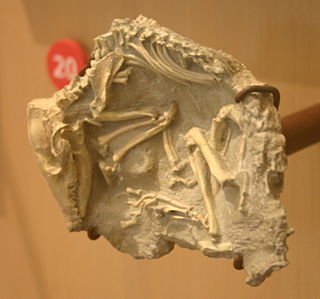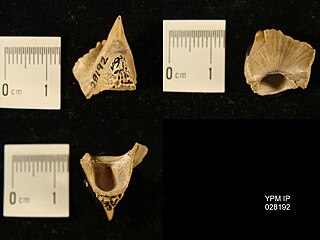
Sclerorhynchus is an extinct genus of ganopristid sclerorhynchoid that lived during the Late Cretaceous. The genus Ganopristis is considered a junior synonym of Sclerorhynchus. It was a widespread genus, with fossils found in the Middle East, North Africa, Europe, and North America. While it had a long rostrum with large denticles similar to sawfishes and sawsharks, its closest living relatives are actually skates. Complete specimens of S. atavus show that its fin arrangement was similar to skates, with the pectoral and pelvic fins touching, both dorsal fins located behind the pelvic fins, and a reduced caudal fin.

Leptictis is an extinct genus of leptictid non-placental eutherian mammal known from the Late Eocene to Early Oligocene of North America. The type species, L. haydeni, was named in 1868 by Joseph Leidy in honour of Ferdinand Vandeveer Hayden. L. dakotensis was also named by Leidy in 1868, but he originally named it as a separate genus, Ictops, which is now seen as the same animal as Lepticitis. Since then, six other species have been named. The hind limbs are proportionally elongated compared to their forelimbs similar to elephant shrews, though to a lesser degree than Leptictidium, and it is suggested that they were capable of rapid bursts of quadrupedal locomotion, unlike the bipedal locomotion suggested for Leptictidium. The forelimbs were likely used for digging.

Toxochelys is an extinct genus of marine turtle from the Late Cretaceous period. It is the most commonly found fossilized turtle species in the Smoky Hill Chalk, in western Kansas.
Jefitchia is an extinct genus of prehistoric drum. Species lived from 48.6–33.9 mya . Jefitchia have been uncovered in Texas, Louisiana, and Portugal.

Belosaepiidae is an extinct, monospecific family of cephalopods known from the Eocene epoch, and bearing close similarity to the sepiid cuttlefish, whilst retaining the remnants of a belemnite-like guard. It is thought that this species was most common for its time.
Diploporus is an extinct genus of conifers in the yew family Taxaceae, containing the single species Diploporus torreyoides known from the middle Eocene of north central Oregon and the Late Paleocene of south central North Dakota. The species was first described from a series of isolated fossil seeds in chert.
The Bashi Formation is a geologic formation in Alabama and Mississippi. It is named for Bashi Creek in northern Clarke County, Alabama, which cuts through some of its exposures. It preserves fossils dating back to the Eocene period, or Wasatchian in the NALMA classification.
This list of fossil fishes described in 2016 is a list of new taxa of jawless vertebrates, placoderms, acanthodians, fossil cartilaginous fishes, bony fishes and other fishes of every kind that have been described during the year 2016, as well as other significant discoveries and events related to paleontology of fishes that occurred in the year 2016. The list only includes taxa at the level of genus or species.

Sclerorhynchoidei is an extinct suborder of rajiform rays that had long rostra with large denticles similar to sawfishes and sawsharks. This feature was convergently evolved, recently proposed as 'pristification', and their closest living relatives are actually skates. While they are often called "sawfishes", sawskates is a more accurate common name proposed in 2021 for sclerorhynchoids, which has been subsequently used by other researchers.

Coniophis is an extinct genus of snakes from the late Cretaceous period. The type species, Coniophis precedes, was about 7 cm long and had snake-like teeth and body form, with a skull and a largely lizard-like bone structure. It probably ate small vertebrates. The fossil remains of Coniophis were first discovered at the end of the 19th century in the Lance Formation of the US state of Wyoming, and were described in 1892 by Othniel Charles Marsh. For the genus Coniophis, a number of other species have been described. Their affiliation is, however, poorly secured, mostly based on vertebrae descriptions from only a few fossils.
Apatemys is a member of the family Apatemyidae, an extinct group of small and insectivorous placental mammals that lived in the Paleogene of North America, India, and Europe. While the number of genera and species is less agreed upon, it has been determined that two apatemyid genera, Apatemys and Sinclairella, existed sequentially during the Eocene in North America. The genus Apatemys, living as far back as 50.3 million years ago (mya), existed through part of the Wasatchian and persisted through the Duchesnean, and Sinclairella followed, existing from the Duchesnean through the Arikareean. Examinations of specimens belonging to the genus Apatemys suggest adaptations characteristic of arboreal mammals.
Aktaua is an extinct genus of sawfish from the Lutetian stage of the Eocene epoch. It is currently known from a single species, A. kizylkumensis. It is found in the White Mountain Formation of Uzbekistan. The species was named for the Kizylkum Desert, in which it was found. The genus name is derived from the Uzbek word for "white," in reference to the formation it was found in.
Ankistrorhynchus is an extinct genus of sawfish-like ray from the Cretaceous Period. It is known only isolated rostral teeth from two species. A. lonzeensis is named for its type locality of Lonzée, Belgium. It is from the lower Santonian stage. A. washakiensis was described from the Campanian-aged Mesaverde Formation of Wyoming, USA. The species A. major was named from Campanian/Santonian of New Jersey, USA off of fragmentary material, thus making its validity questionable.
Burnhamia is an extinct genus of devil ray from the Paleogene period. Due to superficial similarities, some species were originally mistaken for Cownose rays and placed in the genus Rhinoptera. It is known exclusively from dental batteries, mostly isolated teeth. There are several species attributed to this genus but their relation to each other is still unresolved. Some have proposed the type species B. daviesi arises in the late Paleocene and persists until the middle Eocene giving rise to the similar genus Eoplinthicus with an earlier offshoot leading to smaller and less ornamented species in the lower Eocene, namely B. fetahi. B. fetahi is known from Morocco and North America. B. daviesi was described from the London Clay Formation, but is well known from Eocene deposits throughout Asia, Europe, North Africa, and North America. However, teeth from the Claiborne Group of Alabama show teeth identical to B. daviesi coexisting with Eoplinthicus in the Bartonian. A Ypresian species, B. nessovi, known from a singular site in Kazakhstan was tentatively ascribed to the genus, though more material may show it warrant its own. B. crimensis is known from the Bartonian and Priabonian of Crimea.
Uhlia is an extinct genus of coryphoid palm containing a single species Uhlia allenbyensis. The species is known from permineralized remains recovered from the Princeton Chert in British Columbia, Canada. Leaves of Uhlia have "tar spot"-like fungal infections of the extinct ascomycete Paleoserenomyces, which in turn are hyperparasitized by the ascomycete Cryptodidymosphaerites.

Amphissites is an extinct genus of ostracod belonging to the suborder Beyrichicopina and family Amphissitinae. Species belonging to the genus lived from the Devonian to the Permian in Europe, North America, Australia, and east Asia. The genus were likely deposit-feeders, and may have survived briefly into the Triassic.

Ulmus chuchuanus is an extinct species of flowering plant in the family Ulmaceae related to the modern elms. The species is known from fossil leaves and fruits found in early Eocene sites of northern Washington state, United States and central British Columbia, Canada.
This is an overview of the paleofauna of the Eocene Messel Formation as explored by the Messel Pit excavations in Germany. A former quarry and now UNESCO World Heritage Site, the Messel Formation preserves what once were a series of anoxic lakes surrounded by a sub-tropical rainforest during the Middle Eocene, approximately 47 Ma.
This is an overview of the paleoflora of the Eocene Messel Formation as explored by the Messel Pit excavations in Germany. A former quarry and UNESCO World Heritage Site, the Messel Formation preserves what once were a series of lakes surrounded by sub-tropical rainforest during the Middle Eocene, approximately 47 Ma.







